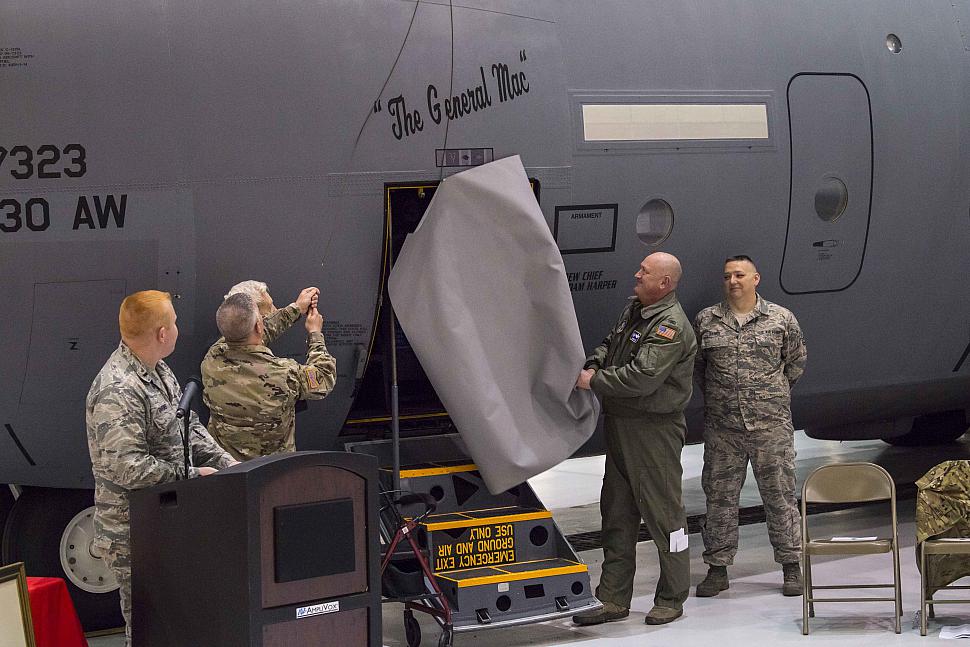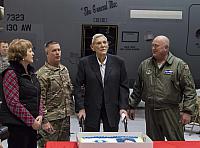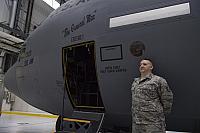C-130 News
C-130 Hercules News
American Hero is honored with plane naming ceremony
December 7, 2017 (by
Amn Caleb Vance) -
December 7 is a date that stands out in American history, but on that date in 1918, a future West Virginia and Air Force legend named James Kemp McLaughlin was born in a small town in Braxton County, W.Va.

Not more than 23 years later on the date of his birth, the Japanese attacked Pearl Harbor, changing U.S. history as we know it, and the course of Kemp McLaughlin’s life.
In September of 1941, Kemp McLaughlin joined the U.S. Army Air Corps as a pilot, noting he enjoyed flying for recreation and thought he’d “try out the Army Air Corps.” Shortly after the attacks of Pearl Harbor that year, his training regiment quickly changed and he would soon find himself assigned to the 92nd heavy bombardment group of the “Mighty” 8th Air Force in Europe. This group is known as one of the first units to see combat in World War II. McLaughlin would later go on to write a book about the “Mighty Eighth” in form of a memoir, recalling the events of his time overseas.
As a young aviator flying among some of the greatest in history, McLaughlin took part in some of the most important battles of World War II. He served as lead bomber in the ball-bearing plant bombing in Schweinfurt, Germany, the largest air raid in history, which helped to destroy 70 percent of the German ball bearing plants. He was also instrumental in deterring the Nazis from developing an atomic bomb, thanks to his actions in bombing facilities in Norway. McLaughlin and the men of the Mighty Eighth, also were instrumental in developing what is known today as “air superiority,” the single most important factor in deciding the outcome of a modern conventional war.
By the wars end and after 31 consecutive months in combat, McLaughlin had reached the rank of Lt. Col. and had participated in 39 bombing missions. He was awarded numerous awards for his actions, some of the most notable being the Distinguished Flying Cross, the French Croix de Guerre and a Presidential Unit Citation.
Following the war, he returned to the United States and eventually found his way back home to West Virginia. In 1947, he accepted a position as commander for the newly founded West Virginia Air National Guard. He would serve as commander for 30 years, leading the unit into active duty in the Korean War, and progressing the organization forward with each passing year.
McLaughlin climbed up the ranks, eventually taking a promotion as the Assistant Adjutant General for Air of the West Virginia National Guard, where he was promoted to Brigadier General. In 1977, he hung up his hat and retired from his position in the West Virginia Air National Guard. He also served as the Kanawha County Commissioner from 1962 to 1968.
“General Mac was a patriot that did great things and sacrificed so much for this country and the state of West Virginia,” said Col. Johnny Ryan, 130th Airlift Wing commander. “I see that in these Airmen today, although we haven't been called to make the sacrifices that they made in 1941, I still see that same patriotism they had.”
Remaining a symbol of the WVANG, McLaughlin Air National Guard Base, the base that houses the 130th Airlift Wing, was renamed in his honor in 2014. On Dec. 7, 2017, in celebration of both McLaughlin’s service and his 99th birthday, the 130th AW dedicated a C-130H #96-7323 in his honor, forever marking the aircraft, “The General Mac.”
“Throughout his 99 years of life, he's been a man of value, a man of standards and respect,” said Maj. Gen. James Hoyer, The Adjutant General of the West Virginia National Guard. “We in the military must continue to be the standard bearer that this [dedication] represents and that General McLaughlin represented not just in uniform, but as a citizen as well.”
Hoyer also went on to state that McLaughlin represents everything the National Guard stands for and that it is just another step towards what we as the National Guard do to recognize and remember someone who has sacrificed and committed so much to this great nation.
From his first aviation mission at the age of 23 being shot at by the German Army, leaving his B-17 in a fiery mess, to flying P-51 Mustangs through the valleys of Charleston, W.Va., to having a plane named after him at the age of 99, McLaughlin’s namesake has been, and will be steadily preserved for years to come.

Col. Johnny Ryan, 130th AW commander, removes the labelling on C-130H #96-7323 during the naming ceremony held December 7, 2017, at McLaughlin ANGB, Charleston. The aircraft was given the name "The General Mac" to honor Brig. Gen. (ret) James K. McLaughlin, who founded the West Virginia ANG and was a pilot in World War II with the famous Eight Air Force. [ANG photo by TSgt. De-Juan Haley]
In September of 1941, Kemp McLaughlin joined the U.S. Army Air Corps as a pilot, noting he enjoyed flying for recreation and thought he’d “try out the Army Air Corps.” Shortly after the attacks of Pearl Harbor that year, his training regiment quickly changed and he would soon find himself assigned to the 92nd heavy bombardment group of the “Mighty” 8th Air Force in Europe. This group is known as one of the first units to see combat in World War II. McLaughlin would later go on to write a book about the “Mighty Eighth” in form of a memoir, recalling the events of his time overseas.
As a young aviator flying among some of the greatest in history, McLaughlin took part in some of the most important battles of World War II. He served as lead bomber in the ball-bearing plant bombing in Schweinfurt, Germany, the largest air raid in history, which helped to destroy 70 percent of the German ball bearing plants. He was also instrumental in deterring the Nazis from developing an atomic bomb, thanks to his actions in bombing facilities in Norway. McLaughlin and the men of the Mighty Eighth, also were instrumental in developing what is known today as “air superiority,” the single most important factor in deciding the outcome of a modern conventional war.
By the wars end and after 31 consecutive months in combat, McLaughlin had reached the rank of Lt. Col. and had participated in 39 bombing missions. He was awarded numerous awards for his actions, some of the most notable being the Distinguished Flying Cross, the French Croix de Guerre and a Presidential Unit Citation.
Following the war, he returned to the United States and eventually found his way back home to West Virginia. In 1947, he accepted a position as commander for the newly founded West Virginia Air National Guard. He would serve as commander for 30 years, leading the unit into active duty in the Korean War, and progressing the organization forward with each passing year.
McLaughlin climbed up the ranks, eventually taking a promotion as the Assistant Adjutant General for Air of the West Virginia National Guard, where he was promoted to Brigadier General. In 1977, he hung up his hat and retired from his position in the West Virginia Air National Guard. He also served as the Kanawha County Commissioner from 1962 to 1968.
“General Mac was a patriot that did great things and sacrificed so much for this country and the state of West Virginia,” said Col. Johnny Ryan, 130th Airlift Wing commander. “I see that in these Airmen today, although we haven't been called to make the sacrifices that they made in 1941, I still see that same patriotism they had.”
Remaining a symbol of the WVANG, McLaughlin Air National Guard Base, the base that houses the 130th Airlift Wing, was renamed in his honor in 2014. On Dec. 7, 2017, in celebration of both McLaughlin’s service and his 99th birthday, the 130th AW dedicated a C-130H #96-7323 in his honor, forever marking the aircraft, “The General Mac.”
“Throughout his 99 years of life, he's been a man of value, a man of standards and respect,” said Maj. Gen. James Hoyer, The Adjutant General of the West Virginia National Guard. “We in the military must continue to be the standard bearer that this [dedication] represents and that General McLaughlin represented not just in uniform, but as a citizen as well.”
Hoyer also went on to state that McLaughlin represents everything the National Guard stands for and that it is just another step towards what we as the National Guard do to recognize and remember someone who has sacrificed and committed so much to this great nation.
From his first aviation mission at the age of 23 being shot at by the German Army, leaving his B-17 in a fiery mess, to flying P-51 Mustangs through the valleys of Charleston, W.Va., to having a plane named after him at the age of 99, McLaughlin’s namesake has been, and will be steadily preserved for years to come.
Courtesy of 130th Airlift Wing Air National Guard
Related articles:
Forum discussion:
Tags
Forum discussion:
- Start a discussion about this article in the C-130.net forum.
Tags
Additional images:

U.S. Army Maj. Gen. James Hoyer, West Virginia National Guard Adjutant General, addresses attendees at an aircraft naming ceremony held December 7, 2017 at McLaughlin ANGB. The aircraft was given the name "The General Mac" to honor Brig. Gen. (ret) James K. McLaughlin who founded the West Virginia ANG and was a pilot in World War II with the famous Eight Air Force. [ANG photo by TSgt. De-Juan Haley]

TSgt. Adam Harper, a crew chief for the 130th Maintenance Group, stands by C-130H #96-7323 at a plane naming ceremony on December 7, 2017 at McLaughlin ANGB, Charleston. The aircraft was given the name "The General Mac" to honor Brig. Gen. (ret) James K. McLaughlin, who founded the West Virginia ANG and was a pilot in World War II with the famous Eight Air Force. [ANG photo by TSgt. De-Juan Haley]
